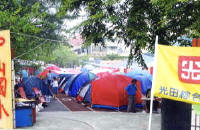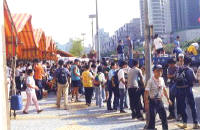The spirit of helping each other exists well in the Taiwanese society.

Around the turn of the millennium, at 1:47 AM in the morning of September 21, 1999, Taiwan was struck by a 7.3 earthquake on the Richter scale. The entire population on this island were waked up by the tumbling roar from the earth. In Taipei, some 200 km from the center of the quake, people felt the immense power. Thousands of houses collapsed and tens of thousands of people injured or died.
Taiwan has created an economic miracle since the 60s. Following the fast pace of urbanization and materialism, some experts worry that Taiwan has lost her purity and moral standard from the rural society in the past. The devastating act of God is testing the people from this island whether they can unite and form a common entity. Following is an abstract of what the author has observed during the period from September 21 to 30, after a couple of trips taken to the disaster area in the middle part of Taiwan.

September 21: After the earthquake, the entire power and communication systems were damaged. From radio we learnt that a 12 stories building in Taipei City has collapsed and over 70 people were trapped. Another 12 stories building in the suburbs of Taipei tumbled down with a death toll of 14 and injuries over 100. Never realized at that time that these were just the beginning of a series of bad news.
Gradually there was news from the central part of Taiwan. More buildings have collapsed. By noontime air search has brought back the heartbreaking fact of the damages in towns and villages near the center of the quake and along the fault lines in Nantou and Taichung Prefectures. In the evening time, the death toll has passed 1,000. Over 4,000 people were wounded and numerous houses fell to the ground.
There was an urgent call for volunteers for the rescue and donation of medical, water and food supplies and all types of blood. At nighttime a part of Taipei City has restored electricity. We saw on TV that there were so many refugees on the streets and in the parks or on school grounds who have lost their homes or they were afraid to go back to their tilted apartments. It occurred to me immediately that they need a temporary shelter - a tent.
September 22: In the morning the author managed to contact the Linko factory and asked them to sort out all the tents in stock. By noontime I have filled my van up with 90 sets of tents and started to drive down south. On the freeway, I have seen rescuing materials loaded on just about all kinds of vehicles heading for the disaster area. All broadcasting stations were giving traffic directions and the latest reports of the incident. One of the touching news was from Taipei. The lines of blood donors were too long and the authorities were asking people to come some later time, if required.
In the news report, we learnt that the Wu-Shi Bridge, which leads to Nantou Prefecture, has fallen down. So we decided to go to Doulio City, which was closer to the freeway and there were also fallen buildings. We couldn't believe our eyes to see the refugees sleeping on open grounds without any shelter. We just left the tents with the rescue center and hurried back to Taipei.
September 23: Loaded the balance of 60 sets of tents into the van and headed toward Wufeng and Nantou. These two places were on the Che-Long-Pu fault line; therefore they were hit hard. The bridges were down and all the first floor poles caved in for the entire block of the apartments. For fairness sake, we left half of the tents at Wufeng and proceeded to Nantou for the delivery of the other half of the tents. On our way back, we heard from the broadcasting, saying that food and water were sufficient, but they needed more tents and sleeping bags.
As we have no more tents left, we started calling all camping friends and neighbors to collect used tents and sleeping bags. We asked broadcasting stations to announce to all secondary schools to offer educational use tents. We even sent a fax to the Minister of Education, appealing him to give an order to the schools for such actions.

September 24: We transported all of the collected tents to the Rescue Command Center situated at the square in front of the Taipei City Hall. There we have seen enthusiastic citizens using motorbikes, cars and trucks to take all kinds of materials to the square for the government to transport to the disaster area. Young volunteers were busying at directing traffic, and packing, hauling and loading the materials. We have met a few camping members from Taipei City Camping Club there, doing the voluntary works.
F.C.C.C. planned originally to hold its 8th National Family Camping Rally between September 24 and 26. They were forced to cancel the Rally. However, Messrs. Lankester Laurina from Holland and Tsuyoshi Suzumura from Japan have already arrived. We rushed to the campsite to meet them. Mr. Suzumura has brought two cases of batteries to contribute to the refugees, which was a noble deed that has touched all of us.
September 25: Gathered with additional used tents and sleeping bags collected from F.C.C.C. members, and the batteries donated by Mr. Suzumura, we started our journey together with Messrs. Laurina and Suzumura to Dongshi, another earthquake-torn town. Because the bridge was broken down, we have to park the van at roadside and entered the town on foot. Everywhere we have seen the same shattered houses and people using tents as their temporary homes.
We resumed working on the 27th, but the supply of electricity was still intermittent, even in Taipei City. On the 28th we watched a news report on TV that students in over a hundred Nantou schools could not go back to school because most of the classrooms were proclaimed "dangerous" buildings. This has driven us the idea to construct temporary classrooms. We contacted those schools that have purchased official tents before to provide these tents. From them and plus some left in stock, we packed 16 sets and drove to Puli, the closest town to the center of the earthquake and erected all of them for the local primary and secondary schools to use as temporary classrooms.

The contemporary science still can't predict the precise time of an earthquake. But good precautionary measures can help lowering the damages. Once a devastating earthquake happened, the scope of rescue, relocation, reconstruction is extensive. As a lover for outdoor activities, we contact more with the nature and thus know more about the pulse of the natural environment.
When you are in the field, you will loose the sense of belonging if you still can't get your tent ready after dark. Even it's a simple tent, you have found the sense of security like in your home. When the houses were damaged or collapsed in the natural disaster, you may not feel too much during the daytime. But by nightfall the sense of fear arises automatically, especially during power failure and the darkness was always there. Therefore, other than the tents, the field equipment for illumination, cooking and sleeping are the most necessary gears that are needed in the short run.
Taiwan has suffered this time the worst earthquake in a hundred years. Nantou Prefecture, where the center of the earthquake was, and its neighboring towns and cities have over 400,000 refugees who either became homeless of dared not to return to their endangered houses or apartments. It's lucky that, starting from the 90s, a lot of Taiwans' families owned tents as the national income increases and the government has enforced alternate Saturday off.
Also, in the curriculum of secondary education in Taiwan, there is a scout education course. This means that each of such school will have some 30 sets of group tents. All together there are about 20,000 sets in Taiwan in total. Starting from the second day after the earthquake, tents from individuals, schools and other groups have gradually reached the disaster area. According to the authors 'estimation, the number of the tents must have exceeded 100,000 sets. This could be the largest national camping activity ever. Unfortunately none of the sad and helpless participants is in the leisurely mood.
In some European cities, you may find some sort of city type campsites in the city parks. These campsites are equipped with shower and toilet facility, which provides the visiting campers the convenience. But other than the schools and parks which have toilets available, the camp area used in the aftermath of the earthquake are either without shower or without both shower and toilet. Sanitation becomes an issue.
We hope that the governments on or near the earthquake belt (Taiwan, Japan and Korea included) shall think seriously to reserve well-equipped campsites in the city parks. They can provide their citizens and visitors good places to enjoy camping in the peacetime and also provide adequate emergency shelters in times of need when disasters like earthquake comes.
In all, we have observed that the people in Taiwan have not turned apathetic because of the change of city life tempo that happened in the society. In time of need, the sympathy and coherence that we found in the old rural days still exist deeply in the hearts of the Taiwanese people. They have certainly demonstrated this long-term heritage in the rescue missions after the gigantic earthquake.
January 2000 (Asia-Pacific News No.5)
- Guidelines for Disaster Control on Campsites
- The Campsite as Disaster Shelter
- Pondering Over the Earthquake in Taiwan














